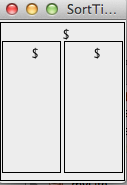- What's a 65 anyways?
- How much material have we covered; how long is break?
- As always
- representation: root, right, left
- operations:
- constructors
- accessors
- isEmpty()
- toString - plain & recursive,
- how to make it look like (anything like) a tree?
- recursion to the rescue! add an indent parameter
- How to paint a tree (instead of printing it sideways)
- write
void paint(Graphics g, int x, int y, int w, int h), orvoid paint(Graphics g, Rectangle r) if (!empty) // avoid infinite recursion draw the root in the middle, near the top left.paint(g, the rectangle which is the left half of the remainder of r, below the root) right.paint(g, the rectangle which is the right half of the remainder of r, below the root)Like this:
- Two Component methods JFrame inherits
Rectangle getBounds()Insets getInsets()
- write
- Testing before use!!
- Making a generic BinaryTree class
- Another kind of abstraction: the pointed brackets enclose another kind of parameter
class BinaryTree<T> { T root; BinaryTree<T> right, left; BinaryTree() { } - Just like ArrayList, now we can specify any type for the root (but watch out! anything you do with the root has to be doable by anything T can be!)
- Another kind of abstraction: the pointed brackets enclose another kind of parameter
int ht(), int countRoots(), int countLeaves(), countInteriorNodes(), traverse() (preorder/inorder
/postorder)- always has a near-delta shape (no degeneracy!)
- every root is <= both children's roots, thus the smallest element is at the root
- insert
insert new element at the insertion point (first empty slot, to the right of the step on the near-delta) swap up to it's proper place (to preserve heapness) i.e. if ! at root of heap if it is < its parent (i.e. is out of place) { swap roots with parent recurse on parent }running time? - delete root
save the root (to return) swap from rightmost, bottom row (to the left of the step on the near-delta) and trim the old root swap the root down to the proper place i.e. if ! a leaf if it is > either child (or just the left, if there's no right) { swap roots with smaller child recurse on that child }running time?
for each element in the list
insert in the heap
list.clear();
while !heap.isEmpty()
list.add(heap.deleteRoot());